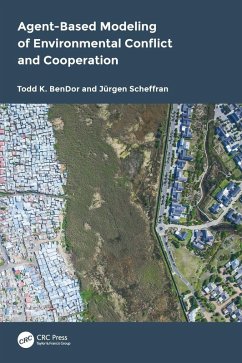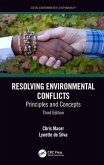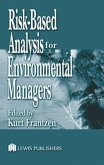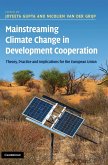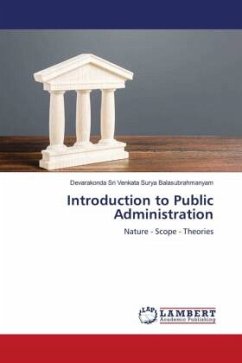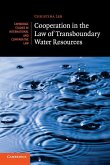- Gebundenes Buch
- Merkliste
- Auf die Merkliste
- Bewerten Bewerten
- Teilen
- Produkt teilen
- Produkterinnerung
- Produkterinnerung
This book examines the recent development and use of computer modeling and simulation as an important tool for understanding environmental and resource-based conflicts and for finding pathways for conflict resolution. It introduces a new, innovative technique for using agent-based modeling as a tool for better understanding environmental conflicts.
Andere Kunden interessierten sich auch für
![Resolving Environmental Conflicts Resolving Environmental Conflicts]() Chris MaserResolving Environmental Conflicts133,99 €
Chris MaserResolving Environmental Conflicts133,99 €![Risk-Based Analysis for Environmental Managers Risk-Based Analysis for Environmental Managers]() Kurt A. Frantzen (ed.)Risk-Based Analysis for Environmental Managers170,99 €
Kurt A. Frantzen (ed.)Risk-Based Analysis for Environmental Managers170,99 €![Risk-Based Analysis for Environmental Managers Risk-Based Analysis for Environmental Managers]() Risk-Based Analysis for Environmental Managers80,99 €
Risk-Based Analysis for Environmental Managers80,99 €![Mainstreaming Climate Change in Development Cooperation Mainstreaming Climate Change in Development Cooperation]() Nicolien van der GrijpMainstreaming Climate Change in Development Cooperation159,99 €
Nicolien van der GrijpMainstreaming Climate Change in Development Cooperation159,99 €![Introduction to Public Administration Introduction to Public Administration]() Devarakonda Sri Venkata Surya BalasubrahmanyamIntroduction to Public Administration29,99 €
Devarakonda Sri Venkata Surya BalasubrahmanyamIntroduction to Public Administration29,99 €![Cooperation in the Law of Transboundary Water Resources Cooperation in the Law of Transboundary Water Resources]() Christina LebCooperation in the Law of Transboundary Water Resources127,99 €
Christina LebCooperation in the Law of Transboundary Water Resources127,99 €![Cooperation in the Law of Transboundary Water Resources Cooperation in the Law of Transboundary Water Resources]() Christina LebCooperation in the Law of Transboundary Water Resources47,99 €
Christina LebCooperation in the Law of Transboundary Water Resources47,99 €-
-
-
This book examines the recent development and use of computer modeling and simulation as an important tool for understanding environmental and resource-based conflicts and for finding pathways for conflict resolution. It introduces a new, innovative technique for using agent-based modeling as a tool for better understanding environmental conflicts.
Produktdetails
- Produktdetails
- Verlag: CRC Press
- Seitenzahl: 366
- Erscheinungstermin: 30. Oktober 2018
- Englisch
- Abmessung: 260mm x 183mm x 24mm
- Gewicht: 883g
- ISBN-13: 9781138476035
- ISBN-10: 113847603X
- Artikelnr.: 54525165
- Herstellerkennzeichnung
- Libri GmbH
- Europaallee 1
- 36244 Bad Hersfeld
- gpsr@libri.de
- Verlag: CRC Press
- Seitenzahl: 366
- Erscheinungstermin: 30. Oktober 2018
- Englisch
- Abmessung: 260mm x 183mm x 24mm
- Gewicht: 883g
- ISBN-13: 9781138476035
- ISBN-10: 113847603X
- Artikelnr.: 54525165
- Herstellerkennzeichnung
- Libri GmbH
- Europaallee 1
- 36244 Bad Hersfeld
- gpsr@libri.de
Professor Todd BenDor is the head of the land use and environmental planning specialization in the Department of City and Regional Planning University of North Carolina at Chapel Hill. His research and teaching focus on producing better ways to understand the impacts that human activities and development can have on sensitive ecological and environmental systems. His research uses both qualitative and quantitative techniques to explore improvements in environmental policy, better and easier to use models of urban growth and change, and improvements in environmental conflict resolution techniques. Dr. BenDor is also the Director of Carolina Planning's Ph.D. Program. Jürgen Scheffran is professor at the Institute of Geography of Universität Hamburg and head of the Research Group Climate Change and Security (CLISEC) in the Excellence Initiative "Integrated Climate Systems Analysis and Prediction" (CliSAP) at KlimaCampus Hamburg. He is Associate Member of the Center for Science and Peace Research (ZNF) and Faculty Affiliate of the Program in Arms Control, Disarmament and International Security (ACDIS) at the University of Illinois. After his physics Ph.D. at the University of Marburg he worked in the Interdisciplinary Research Group IANUS and the Mathematics Department of the Technical University of Darmstadt, at the Potsdam Institute for Climate Impact Research (PIK), and as Visiting Professor at the University of Paris (Sorbonne). Before he came to Hamburg in August 2009, he spent five years at the University of Illinois at Urbana-Champaign (UIUC), where he held positions in the Departments of Political Science and Atmospheric Sciences, at ACDIS and the Center for Advanced BioEnergy Research (CABER).
Part I: Conflict and the Promise of Conflict Modeling 1. Environmental
Conflicts in a Complex World 2. Why Model? How Can Modeling Help Resolve
Conflict? 3. The History and Types of Conflict Modeling 4. Participatory
Modeling and Conflict Resolution Part II: Modeling Environmental Conflict
5. System Dynamics and Conflict Modeling 6. Agent-Based Modeling and
Environmental Conflict 7. Modeling Conflict and Cooperation as Agent Action
and Interaction Part III: Applications of the VIABLE Model Framework 8. A
Viability Approach to Understanding Fishery Conflict and Cooperation 9. An
Adaptive Dynamic Model of Emissions Trading 10. Modeling Bioenergy and Land
Use Conflict 11. The Future of Modeling Environmental Conflict and
Cooperation
Conflicts in a Complex World 2. Why Model? How Can Modeling Help Resolve
Conflict? 3. The History and Types of Conflict Modeling 4. Participatory
Modeling and Conflict Resolution Part II: Modeling Environmental Conflict
5. System Dynamics and Conflict Modeling 6. Agent-Based Modeling and
Environmental Conflict 7. Modeling Conflict and Cooperation as Agent Action
and Interaction Part III: Applications of the VIABLE Model Framework 8. A
Viability Approach to Understanding Fishery Conflict and Cooperation 9. An
Adaptive Dynamic Model of Emissions Trading 10. Modeling Bioenergy and Land
Use Conflict 11. The Future of Modeling Environmental Conflict and
Cooperation
Part I: Conflict and the Promise of Conflict Modeling 1. Environmental Conflicts in a Complex World 2. Why Model? How Can Modeling Help Resolve Conflict? 3. The History and Types of Conflict Modeling 4. Participatory Modeling and Conflict Resolution Part II: Modeling Environmental Conflict 5. System Dynamics and Conflict Modeling 6. Agent-Based Modeling and Environmental Conflict 7. Modeling Conflict and Cooperation as Agent Action and Interaction Part III: Applications of the VIABLE Model Framework 8. A Viability Approach to Understanding Fishery Conflict and Cooperation 9. An Adaptive Dynamic Model of Emissions Trading 10. Modeling Bioenergy and Land Use Conflict 11. The Future of Modeling Environmental Conflict and Cooperation
Part I: Conflict and the Promise of Conflict Modeling 1. Environmental
Conflicts in a Complex World 2. Why Model? How Can Modeling Help Resolve
Conflict? 3. The History and Types of Conflict Modeling 4. Participatory
Modeling and Conflict Resolution Part II: Modeling Environmental Conflict
5. System Dynamics and Conflict Modeling 6. Agent-Based Modeling and
Environmental Conflict 7. Modeling Conflict and Cooperation as Agent Action
and Interaction Part III: Applications of the VIABLE Model Framework 8. A
Viability Approach to Understanding Fishery Conflict and Cooperation 9. An
Adaptive Dynamic Model of Emissions Trading 10. Modeling Bioenergy and Land
Use Conflict 11. The Future of Modeling Environmental Conflict and
Cooperation
Conflicts in a Complex World 2. Why Model? How Can Modeling Help Resolve
Conflict? 3. The History and Types of Conflict Modeling 4. Participatory
Modeling and Conflict Resolution Part II: Modeling Environmental Conflict
5. System Dynamics and Conflict Modeling 6. Agent-Based Modeling and
Environmental Conflict 7. Modeling Conflict and Cooperation as Agent Action
and Interaction Part III: Applications of the VIABLE Model Framework 8. A
Viability Approach to Understanding Fishery Conflict and Cooperation 9. An
Adaptive Dynamic Model of Emissions Trading 10. Modeling Bioenergy and Land
Use Conflict 11. The Future of Modeling Environmental Conflict and
Cooperation
Part I: Conflict and the Promise of Conflict Modeling 1. Environmental Conflicts in a Complex World 2. Why Model? How Can Modeling Help Resolve Conflict? 3. The History and Types of Conflict Modeling 4. Participatory Modeling and Conflict Resolution Part II: Modeling Environmental Conflict 5. System Dynamics and Conflict Modeling 6. Agent-Based Modeling and Environmental Conflict 7. Modeling Conflict and Cooperation as Agent Action and Interaction Part III: Applications of the VIABLE Model Framework 8. A Viability Approach to Understanding Fishery Conflict and Cooperation 9. An Adaptive Dynamic Model of Emissions Trading 10. Modeling Bioenergy and Land Use Conflict 11. The Future of Modeling Environmental Conflict and Cooperation

